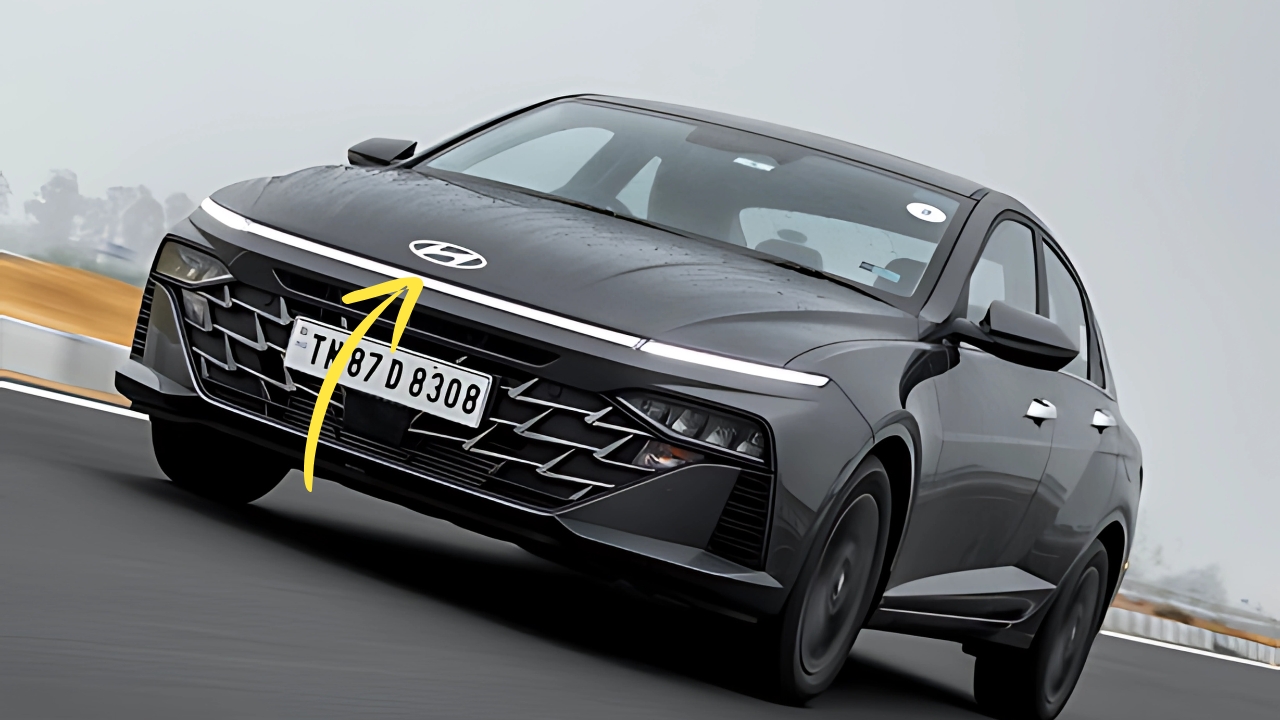Hyundai Verna: In the ever-evolving landscape of automotive design and technology, few segments have witnessed as dramatic a transformation as the compact sedan category.
Once relegated to the role of uninspiring economy transportation, these vehicles have evolved into sophisticated, feature-rich offerings that challenge preconceived notions of what an affordable sedan can be.
The Hyundai Verna stands as perhaps the most compelling example of this metamorphosis, particularly in its latest iteration that arrived in early 2025.
Hyundai Verna: Design Language: Breaking Conservative Molds
The current Verna represents a bold departure from the conservative styling that once defined this segment.
Drawing inspiration from Hyundai’s “Sensuous Sportiness” design philosophy, the sedan features a striking front fascia dominated by a wide, parametric-pattern grille that seamlessly integrates with the sleek LED headlamps.
This connected lighting arrangement creates a distinctive light signature that remains recognizable even at a distance – a crucial brand-building element in today’s crowded automotive marketplace.
In profile, the Verna adopts a fastback-inspired silhouette that cleverly disguises its sedan configuration, with a gently sloping roofline that extends into a short deck lid.
Character lines along the body sides create interesting light plays that add visual drama without appearing overwrought.
The rear treatment continues the contemporary theme with connected LED tail lamps spanning the width of the trunk, lending the vehicle a premium appearance that belies its price point.
Available in seven exterior colors, including the eye-catching Fiery Red and Starry Night blue, the Verna allows for meaningful personalization.
Alloy wheel designs range from 16 to 17 inches depending on trim level, with higher-end variants featuring machined two-tone finishes that enhance the vehicle’s upmarket aspirations.
Cabin Experience: Redefining Expectations
Step inside the Verna, and it becomes immediately apparent that Hyundai has abandoned the notion that compact sedans must feel compromised.
The horizontal dashboard layout emphasizes width, creating an impression of spaciousness that’s reinforced by thoughtful material choices and attention to detail.
Soft-touch surfaces appear in areas where occupants regularly interact, while piano black accents and metallic trim pieces add visual interest without appearing tacky or overdone.
The front seats offer surprisingly generous support for extended journeys, with multi-way power adjustment available on upper trims.
Rear accommodations provide adequate legroom for adult passengers, though taller individuals may find headroom slightly compromised by the stylish roofline – an acceptable tradeoff for many given the exterior aesthetics.
The 528-liter trunk capacity ranks among the segment’s most generous, easily accommodating luggage for weekend getaways or bulky grocery runs.
Perhaps most impressive is the cabin’s refinement. Extensive use of sound-deadening materials and acoustic glass on premium variants results in notably reduced road and wind noise, creating an atmosphere more commonly associated with vehicles from higher price brackets.
This attention to the sensory experience elevates the Verna beyond mere transportation into something approaching entry-level luxury territory.
Technological Integration: Digital Sophistication
The centerpiece of the Verna’s interior is undoubtedly its impressive technological suite. A 10.25-inch touchscreen infotainment system dominates the center stack, offering crisp graphics and responsive touch inputs.
This is complemented by a matching 10.25-inch digital instrument cluster on higher trims, creating a cohesive, tech-forward cockpit environment.
Wireless Apple CarPlay and Android Auto compatibility come standard across the range, while higher specifications add built-in navigation with over-the-air map updates.
The available Bose premium audio system delivers impressive sound quality through eight strategically placed speakers, while dual-zone automatic climate control allows personalized comfort settings for front occupants.
A wireless charging pad accommodates compatible devices, and multiple USB-C ports ensure connectivity for all passengers.
Hyundai’s BlueLink connected car technology enables remote engine start, climate control preconditioning, vehicle location services, and various diagnostic features via smartphone application.
Voice recognition capabilities extend beyond basic commands to include natural language processing that can adjust vehicle settings or provide information without requiring hands to leave the steering wheel.
Performance Dynamics: Balanced Capability
Under the hood, the Verna offers two powertrain options that prioritize different aspects of the driving experience.
The standard 1.5-liter naturally aspirated four-cylinder engine produces 115 horsepower and 144 Nm of torque – adequate figures for everyday driving scenarios while delivering impressive fuel economy of approximately 19.5 km/l when paired with the continuously variable transmission (CVT).
The more compelling option for enthusiast drivers is the 1.5-liter turbocharged GDI engine, generating 160 horsepower and a substantial 253 Nm of torque available from just 1,500 rpm.
This provides the Verna with surprisingly spirited acceleration, with the 0-100 km/h sprint dispatched in approximately 8.0 seconds when equipped with the seven-speed dual-clutch transmission.
Despite its performance orientation, this powertrain still manages respectable efficiency of around 18 km/l under mixed driving conditions.Regardless of engine choice, the Verna demonstrates commendable road manners.
The chassis strikes a well-judged balance between ride comfort and handling composure, absorbing road imperfections without feeling disconnected from the driving experience.
The electrically assisted power steering offers adequate feedback during spirited cornering while remaining appropriately light for parking maneuvers.
This duality of character – comfortable commuter during weekday traffic and willing companion on weekend backroads – represents a significant engineering achievement at this price point.
Safety Architecture: Comprehensive Protection
Safety features have evolved dramatically in this segment, and the Verna showcases Hyundai’s commitment to occupant protection.
Six airbags come standard across the range, as do electronic stability control, vehicle stability management, and hill-start assist.
Higher trims add Hyundai’s SmartSense suite of advanced driver assistance systems, including forward collision avoidance with pedestrian detection, lane keeping assist, blind-spot collision warning, and rear cross-traffic alert.
The underlying structure incorporates high-strength steel for 79% of its composition, creating a robust safety cage while simultaneously reducing weight to benefit both efficiency and handling.
This architectural approach has earned the Verna impressive crash test ratings that provide peace of mind for safety-conscious buyers.
Market Positioning: Strategic Placement
The Verna occupies a strategically important position within Hyundai’s lineup and the broader compact sedan segment.
Priced between approximately ₹10.5-17.5 lakh (depending on variant and region), it positions itself as a premium offering within the mainstream sedan category without encroaching on luxury territory.
This pricing strategy places it in direct competition with established rivals like the Honda City, Maruti Suzuki Ciaz, and Volkswagen Virtus.
The Verna differentiates itself through its bold styling, technological integration, and comprehensive feature set – appealing particularly to younger buyers who prioritize design and connectivity over more traditional sedan virtues.
The vehicle’s success in various international markets (where it’s sometimes known as the Accent or Solaris) has allowed Hyundai to amortize development costs across significant volume, enabling the impressive feature content at competitive price points.
This global platform approach, combined with localized production in key markets, represents a sophisticated business strategy that benefits end consumers through better value propositions.
Hyundai Verna: Evolutionary Excellence
The Hyundai Verna exemplifies how far the compact sedan segment has progressed over the past decade.
No longer merely affordable transportation, these vehicles now offer design, technology, comfort, and performance characteristics that would have seemed implausible in this category not long ago.
In its transition from basic transportation to aspirational product, the Verna reflects broader societal shifts in consumer expectations.
Today’s buyers, even in value-oriented segments, demand experiences rather than mere functionality – emotional connections rather than simple utility.
The Verna delivers this more sophisticated proposition while maintaining the practical virtues that made compact sedans popular in the first place.
For consumers who prefer the traditional sedan body style over increasingly ubiquitous crossovers, the Verna presents a compelling case that the format remains relevant and desirable when executed with vision and attention to detail.
In challenging preconceived notions of what an affordable sedan can be, Hyundai has created not just a competitive product, but a benchmark against which rivals must now measure themselves.
Also read this –

